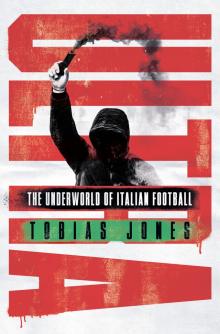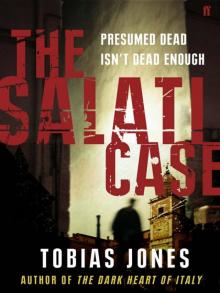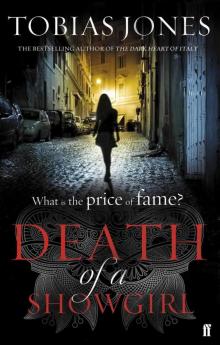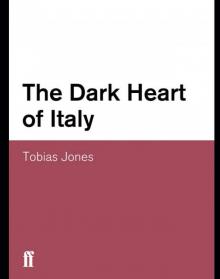- Home
- Tobias Jones
The Dark Heart of Italy Page 4
The Dark Heart of Italy Read online
Page 4
Granted, this document you talk about might serve your purpose – that is, to relieve you of this stupid curiosity of yours. But you don’t have it, and so here you are, damned to the marvellous torment of finding here before your eyes on the one hand a world of fantasy and on the other a world of reality, and you are unable to distinguish one from the other.10
It was this side of Italy which, I slowly realised, was at the root of those worried warnings I had received when I arrived. Nothing, I was repeatedly assured, would ever become clear. ‘If you’re a journalist, forget it,’ they seemed to be saying. ‘You can guess at what has been going on, but no one will ever get close to the truth.’ One Italian historian, for example, has written of Italy’s post-war history as something ‘partly submerged, dark, not revealed because perhaps not revealable, not mentionable, as if it were the history of a grim divinity’.11
I realised that it was, as Pirandello wrote, impossible to distinguish fantasy from reality. The words history and story are the same in Italian (storia). Unless it’s defined, or given a definite article, storia could be a tale from true life or simply make-believe. You wouldn’t know unless you asked. Even if you do, it’s often hard to believe. The deeper I delved, the more Italy’s post-war history seemed a sort of magic realism, full of symbolism and surreal touches: ‘Italy,’ wrote Pier Paolo Pasolini, ‘is a ridiculous and sinister country. Its powers are comic masks, vaguely stained with blood …’12 Even today, given the levels of intrigue and drama, real life crimes are always called gialli (literally ‘yellows’, or ‘thrillers’). Newscasters often excitedly introduce news of a murder or kidnapping as un giallo incredibile. That’s probably why, despite the huge success of Giuseppe Tomasi di Lampedusa’s The Leopard, there are barely any other (comparatively recent) historical novels in Italy: the factual, true-life version simply couldn’t be bettered. The best writers on Italy in the post-war period have been well aware of that ‘thrilling’ side to Italian life in which the divide between fact and fiction appears paper-thin. Leonardo Sciascia wrote about the ‘untouchable, literary perfection’ of one tragic Italian ‘thriller’;13 Umberto Eco wrote about the same event: ‘this would be a joke if the novel were not written with blood’14 One British historian, commenting on another post-war giallo, wrote that it seemed ‘to come straight from a best-selling novel’.15
As I began trying to distinguish histories from stories, there was one image of voluptuous secrecy that stuck in my mind: ‘Italy is really like a great, mythological artichoke … A single flower, green and purple, where each leaf hides another, each layer covers another layer, jealously hidden. He who knows how to take off the outside leaves will discover unimaginable things, in a difficult voyage in time and space.’16 Despite the warnings, I decided to make that difficult voyage, to travel in time and space across the country.
Referances - 1 Parole, Parole, Parole
1 James T. Boulton, ed. The Letters of D. H. Lawrence, vol. 1 (Cambridge, 1979)
2 Carlo Levi, Christ Stopped at Eboli (London, 1947)
3 Marco Rogari, Burocrazia Fuorilegge (Milan, 2001)
4 Corrado Stajano, L’Italia nichilista (Milan, 1982)
5 Jacob Burckhardt, The Civilization of the Renaissance in Italy (London, 1990)
6 Luigi Barzini, The Italians (London, 1964)
7 Ernesto Galli della Loggia, L’identità italiana (Bologna, 1998)
8 Dante, The Divine Comedy (trans. Peter Dale, London, 1996)
9 Carlo Ginzburg, The Judge and the Historian (London, 1999)
10 Luigi Pirandello, “So It Is (If You Think So)” in Six Characters in Search of an Author and Other Plays (trans. Mark Musa, London, 1995)
11 Maurizio Dianese and Gianfranco Bettin, La Strage (Milan, 1999)
12 Pier Paolo Pasolini, Lettere Luterane (Turin, 1976)
13 Leonardo Sciascia, L’Affaire Moro (Milan, 1994)
14 Umberto Eco, Sette anni di desiderio (Milan, 1983)
15 Donald Sassoon, Contemporary Italy (New York, 1997)
16 Carlo Levi, Le mille patrie (Rome, 2000)
2
‘The Mother of All Slaughters’
See, in these silences where things
give over and seem close to betraying
their final secret,
at times we feel we’re about
to discover an error in Nature,
the dead point of the world, the link that won’t hold,
the thread to untangle that will finally lead
to the midst of truth.
Eugenio Montale
The first year I spent in Italy was idyllic. Any sense of melancholy melted away under so much clear, blue sky, and everything seemed more serene and civilised than in Britain. I was earning money in the least arduous way, writing random articles for editors in London: I would be sent to taste the wine on the steep vineyards of the Ligurian coast, or else dispatched to review the pastel colours of restored frescos in Florence. If I were ever short of money, I could sit and chat to a friend in English for a while, and they would duly pay for my ski pass in the Alps. At the end of each week, I would sit down and drink a tiny coffee in Parma’s main square, getting just enough of a rush to realise how incredibly relaxed I was.
Then, each weekend we would drive into the mountains. It was like walking into one of those famous landscape paintings: suddenly we were surrounded by the Arcadian scene of children playing in lakes or waterfalls, behind them the warm pink stone of a distant city in the sunset. We would always eat lunch surrounded by the rhythmic drone of cicadas and protected from the heat by a canopy of wisteria. As always, the food would be a combination of simplicity and extreme sophistication. If anyone was still hungry, or even awake, at the end of the meal they could just wander into the orchard to collect another course.
They were blissful days, but they were, I knew, essentially escapist. Nothing I was writing was remotely connected to Italian reality: it was all cuisine and culture and nothing else. By contrast, the front-page scoops of Italian newspapers, and hours of chat shows, were dedicated to something very different. They seemed obsessed with a strange kind of news story, which wasn’t properly news at all. Everything seemed to be about iconic crimes from decades ago. Unfamiliar with the misteri d’Italia, I often found the headline splashes incomprehensible: ‘Sisde Silted Up The Monster Of Florence’, for example. There’s nothing the dictionary can do to help explain that sentence. And if you ask a friend what it means, they will pause for a long time before slowly sitting down and explaining, with slight embarrassment, the implications of the story. That particular headline referred to the discovery that the Monster of Florence, who decades ago had murdered copulating couples in Tuscany, enjoyed protection from the secret services because he was, allegedly, working on behalf of a clique of aristocratic perverts. Another example of a front-page scoop might be about the kidnap and murder of Aldo Moro, or else something called Gladio.
It was as if a large number of Italian journalists, academics and judges were still trying to solve whodunits from many years ago. The list of the mysteries was endless, as were the theories they spawned. The weekly revelations surrounding such crimes – like that one about the Monster of Florence – often appeared incredible. Invariably, the secret services were involved. Accusations normally ricocheted towards parliament, where someone was suspected of being the Grande Vecchio, the ‘grand old man’ who had pulled the hidden strings of Italy’s post-war history.
It all sounds like an acute case of paranoia, especially when people try and link up the mysteries and end up with theories that look like something cobbled together from the X-Files. Yet, when you start reading newspaper cuttings and books on the mysteries you realise that there really is something very unusual going on. It’s not just that there’s so much murderous intrigue, or that there’s such an appetite for it; it’s that nothing is ever resolved. That’s why the front pages of newspapers are still dominated by facts about those iconic crimes, because there has never –
despite the yearning to know the truth about Italy’s many ‘illustrious corpses’ – been an adequate explanation for what really happened.
In the mystery industry, the word strage is a particularly emotive one. It means ‘slaughter’ and is used to refer to those bombings, from the 1960s to the 1980s, in Milan, Brescia, Bologna and elsewhere, in which all evidence suggested the participation of Fascist terrorists, but which have rarely, if ever, seen the convictions of those responsible. At random intervals, the slaughters killed ordinary members of the public, in banks, on trains, at railway stations. If their effects were horrific, the consequences were perhaps even worse, showing that the physiology of Italy’s democracy was assaulted by the ‘cancer of secrecy’, by a ‘bacillus’ which ‘fed upon itself, degenerating and corrupting the texture of the state.’1 The sheer inscrutability of Italy’s slaughters, and the desire to understand, finally, the mysteries of those ‘Fascist’ bombings, led to the creation in 1988 of a bizarre parliamentary commission. It’s called the Commissione Stragi, the ‘Slaughter Commission’. Its full title is ‘The Parliamentary Commission of Inquiry into Italian Terrorism and into The Reasons for the Failed Individuation of Those Responsible for the Slaughters’. The more I read about the Slaughter Commission, the more intriguing I found it. I was fascinated not so much by the historical task the Commission had been set, but by something rather different. Why is it that there are so many mysteries in Italy? Why is it that no journalist or historian or judge can ever say what’s been going on? I was interested not in finding out the truth about the slaughters (an undertaking which I suspected would be doomed from the outset), but in explaining to myself why, in Italy, truth never seems to emerge. How does that Italian ‘veil’ – beautiful and concealing and intriguing – really work?
My first brush with the Slaughter Commission came in the summer of 2000, when I received an invitation to one of their press conferences in Rome. I spent the four-hour train journey reading newspaper cuttings from the 1960s and 1970s. Accompanying each article would be a photograph of another slaughter: a pavement peppered with blood, corpses lying with limbs at odd angles; torsos slumped over steering wheels or broken bodies found at the bottom of stairwells. Rather strangely, the venue given for the Slaughter Commission’s event was Botteghe Oscure – ‘Dark Stores’ – the street in Rome formerly synonymous with the Communist party and now home to its reincarnated self, the Democrats of the Left. I walked up to the first floor where the Commission’s most recent report was being presented. The room was full of those politicians and judges famous for their investigations into the slaughters from 1969 to 1984. A report, coming in at a modest 326 pages, was being handed round. It was entitled ‘Slaughters and Terrorism in Italy from 1945 to 1976’.
Of course, all was not quite as it seemed. I quickly flicked through the doorstep of paper on my lap and realised something was amiss. The work wasn’t that of all twenty parliamentary deputati and twenty senatori supposed to make up the Commission, but simply the work of a breakaway eight members of it, all ‘Democrats of the Left’. Hence, I realised with sinking heart, the location. The report, which was presented as a bringing together of all the recent trials and research, certainly didn’t pull its punches: the slaughters ‘were organised, promoted and supported by men within Italian institutions and by people linked to American intelligence …’ The central plank of the report was that America’s arrival in Sicily in 1943 represented the beginning of the ‘American war against Italy, which was to impede with every means the autonomous decision of who to have govern us …’ Nor was the Vatican spared a swipe: the saintly seat, ‘having maintained an attitude ambiguous, to say the least, to Fascism, declared itself in favour of whatever intervention necessary on the part of the USA …’
The Slaughter Commission was supposed to be part of an Italian peace process, something like the South African Truth Commission. But that day in Rome was rather like watching an arguing couple who, each time they approach each other, seemingly about to make up, suddenly realise they can’t do it, can’t resist the opportunity for one last verbal volley. Those who wrote the report even made explicit their disdain for the ‘culture of pacification’ because the price of a ‘sort of general amnesty, cultural, political and legal’ is too high: it would require assigning ‘equal dignity to the warring sides … with reciprocal recognition and legitimation’. ‘We don’t want to re-raise The Wall,’ says one of the politicians from the Democrats of the Left at the press conference, ‘just throw some light on some pages which have been kept buried …’ ‘We don’t want to use history as a cudgel’ assures the Commission’s President, Giovanni Pellegrino.
The climax of the document is the allegation that Senator Maceratini, the current parliamentary head of the National Alliance (the reincarnated Movimento Sociale Italiano, the postwar Fascist party, then in the opposition coalition with Silvio Berlusconi’s Forza Italia), had ‘never done his accounts with the past’. Maceratini, the report said, was the filter between the far-right and the neo-Fascists. ‘It’s documented,’ the report went on, ‘that even in the years following those of the so-called “strategy of tension”, Senator Maceratini continued to have political links with personalities from the subversive right who have already been investigated and each time convicted with definitive sentences for terrorist episodes or for reconstituting the Fascist party …’
Within minutes there was a swift response from the right. Gustavo Selva, one of Maceratini’s colleagues in the National Alliance, said that the Slaughter Commission’s research ‘seems like a document from the Red Brigades [the left-wing terrorist organisation] …’ Another spokesman called it ‘Stalinist’, another said: ‘Incredible, worthy of a little Maoist group from the 1970s’. For his part, Senator Maceratini affirmed that he’s ‘proud’ of having ‘operated’ in Ordine Nuovo (a splinter group to the right of the MSI). Asked if it was true that as recently as 1997 he had meetings with members of the extreme right, he replied, ‘It’s possible that they happened,’ before slipping into the classic defence of a convenient mnemonic gap: ‘… but I don’t have a dazzling memory.’ The entire day felt like something from the Cold War: knee-jerk accusations and denials, visceral loathing. Low blows were aimed from moral high-grounds. There was even a sense of excitement, of glee, at the opportunity to return to the fray. The Slaughter Commission, I quickly realised, was as much a part of the problem as the solution, raising ghosts as much as laying them to rest. It became very obvious that there’s nothing in Italy, least of all history, which isn’t fiercely politicised.
‘Think it’s true?’ I asked one of the Italian reporters next to me, who duly put his chin in the air and shrugged his shoulders in dramatic slow-motion. ‘E che ne so io?’, ‘What do I know?’ He looked at me and smiled, as if the question were rather risible. Later I go for a drink with a friend. ‘Of course it’s true. It’s not that mud in Italy doesn’t stick,’ he says; ‘it’s that there’s so much of it that it doesn’t even matter if it does …’
There was one particular piazza in Milan which kept being mentioned in newspapers’ front-page scoops from the past. In the centre of the piazza is the fountain that gives it its name: Piazza Fontana. It has the feel of a swollen side-street, leading somewhere else. Barely a few hundred metres away, in Piazza del Duomo, people gawp at the flying buttresses of the cathedral. Backpackers plait coloured threads into their hair and share benches with older, more earnest sightseers with their guidebooks open on their laps. But nearby, Piazza Fontana remains untouched by tourism.
Historians, though, have seen in its dreadful bombing a pivot in Italian post-war history. The epic enigma of that bomb on 12 December 1969 has become emblematic of the entire country’s subterfuge, and the slaughter is endlessly revisited in the hope of finding, as Corrado Stajano wrote, ‘the key to understanding the history of the last twenty [now over thirty] years’. Understand Piazza Fontana, the theory goes, and you can uncover the sinister truth of modern Italy. It has become
a sort of historical Holy Grail which, if located, could prove a source of beatific, and horrific, revelations. The bomb has hung over the country like a fatal contagion. Many who might have come close to explaining what happened on that day, and in the days and years immediately after, have become themselves additions to Italy’s long list of ‘illustrious corpses’. Suspects, witnesses, carabinieri and magistrates, all became additional, indirect casualties of the Piazza Fontana bomb (‘the mother of all slaughters’), victims of an escalating cycle of recrimination. With each subsequent death, the imperative for an explanation for Piazza Fontana became both more pressing and more improbable.
If you approach Milan in the spring, the air in the suburbs will be full of white piumini – pollen from the poplar trees – which waft in the air like overgrown, ethereal snowflakes in the sun. In the city, squeezed between chic boutiques at regular intervals, are narrow bars, full of mirrors and curling chrome. Men and women are drinking thimbles of coffee. If you walk along the city’s wide boulevards or alongside its narrow canals, the place feels more Teutonic than Latin: bustling, business-like. Sparks fall like rain from scaffolding overhead, and trams clatter past. The city is industrious and wealthy. It’s home to two of the country’s most famous industries, fashion and football. It’s also home to the borsa, the country’s stock-exchange, and you can often see small-crowds gather on the pavements outside banks, from where big screens project to the outside world the latest stock market quotations. Milan, many proud Lombards will tell you, is the real capital of Italy.

 Ultra
Ultra The Salati Case
The Salati Case Death of a Showgirl
Death of a Showgirl The Dark Heart of Italy
The Dark Heart of Italy